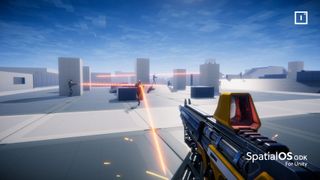Making huge online games just got a whole lot easier
Improbable has released a new Game Development Kit that makes online game creation much easier.
Players love online games – but, for developers, creating high-performing and stable online multiplayer is a tough challenge. A small development team doesn't want to manage networking and servers – it's difficult, tedious and expensive, and takes time and skill away from making a great game. London tech firm Improbable is seeking to democratise that process, by revolutionising the tools necessary to create and scale virtual worlds for online multiplayer gaming...

Improbable has already released SpatialOS, a suite of tools and services that enable games to be easily created, iterated and run in the cloud. But now it’s created two new Game Development Kits (GDKs), one for each of the popular game engines Unity and Unreal. These enable game developers to create and scale online games using those engines more naturally and rapidly, allowing programmers and technical artists to see their work running in a live online game more quickly, and develop that game more effectively.
“We had a lot of feedback from developers that our technology was impressive but that they wanted it to work more closely with Unreal and Unity,” said Paul Thomas, who oversees SpatialOS at Improbable. “So, we’ve made each of the GDKs stay inside the engine’s workflow as much as possible.”
The SpatialOS GDK for Unity was released in early October, and already has thousands of developers using it; a similar GDK for Unreal Engine is due out at the end of the month.
Veteran developer Trond Fasteraune (Beyond the Sleep) has been using SpatialOS and the GDK for Unity to create something he calls a mini-MMO. His unique design features a flexible number of players, asymmetric gameplay, persistent base-building and AI factions. So far, he’s impressed.
“For a very long time, programming the networking part of an online game has been reserved for the most experienced developers,” says Fasteraune. “For that reason, not many multiplayer games have been made from scratch by smaller studios. Now, with SpatialOS, network compression, security and optimisation are automatically handled for you. Design and implementation is the main focus, as the programming can be done even by junior programmers. The work is now, more or less, high-level programming.”
For new users, Improbable has put together a 200-person example first-person combat game. Developers are free to play around with it, remix it into their own groundbreaking games and run test deployments for free on Improbable’s cloud servers.
“This FPS Starter Project is designed to make it so that developers can get a SpatialOS test game up and running immediately,” says Thomas. “We’ve included all the assets, maps, textures and so on, so it’s up to the developer how much they customise their experience. We’re excited to see what people do!” Already, Improbable’s graduate engineers have been jamming with the project, turning the game into a Battle Royale, King of the Hill, or into other traditional genres and styles.
This is just the start: After the release of the GDK for Unreal on October 25th, Improbable’s engineers will support the kits with smaller releases – off-the-shelf packages for important elements of game design – such as pre-built health systems, control schemes, multiple platforms, and so on. And, whilst the free tier of SpatialOS offers developers around 200 players, higher tiers enable users to create SpatialOS game worlds with thousands of players and tens of thousands of AIs.
“We really do want to make it so you can make any kind of multiplayer experience on SpatialOS, with any game engine, ranging from small-scale co-operative games and 200-person FPSes to fully-fledged MMORPGs and grand strategy games on a global scale,” said Thomas. “The new hard limit isn’t CPU power or engine constraints – it’s your imagination.”
For more information or help getting started, head to Improbable’s site.

Thank you for reading 5 articles this month* Join now for unlimited access
Enjoy your first month for just £1 / $1 / €1
*Read 5 free articles per month without a subscription

Join now for unlimited access
Try first month for just £1 / $1 / €1
Get the Creative Bloq Newsletter
Daily design news, reviews, how-tos and more, as picked by the editors.
The Creative Bloq team is made up of a group of design fans, and has changed and evolved since Creative Bloq began back in 2012. The current website team consists of eight full-time members of staff: Editor Georgia Coggan, Deputy Editor Rosie Hilder, Ecommerce Editor Beren Neale, Senior News Editor Daniel Piper, Editor, Digital Art and 3D Ian Dean, Tech Reviews Editor Erlingur Einarsson and Ecommerce Writer Beth Nicholls and Staff Writer Natalie Fear, as well as a roster of freelancers from around the world. The 3D World and ImagineFX magazine teams also pitch in, ensuring that content from 3D World and ImagineFX is represented on Creative Bloq.
